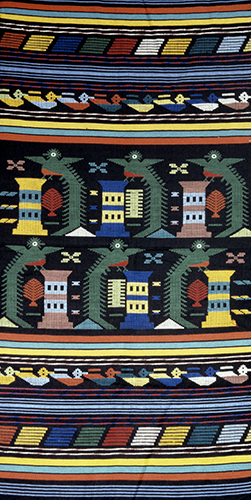Mayan Textiles
I am always fascinated when I stop to think about indigenous cultures that have flourished culturally for many, many centuries. True, we in the West consider the ancient Greek and Roman cultures as our distant ancestors, but our society (the US) did not originate on this continent.
Despite colonization by the Spanish, indigenous cultures of Central and South America have maintained many distinctive art forms that have their antecedents in ancient times. This is definitely true of the Maya of Guatemala. And let’s keep in mind that the classic period of the Maya people, when their culture was at its height (around 250 to 900 CE), was the time of the “Dark Ages” in Europe, while India and China were in their “Golden Age.”
 |
| Kiche Maya People (Guatemala), Tourist Wall Hanging with Quetzal and Duck Design, 1970s. Cotton, height: 47 ¼" (120 cm). Private collection. Photo © Davis Art Images. (8S-21133) |
The Maya culture can be traced back as far as 1500 BCE, and at its height extended from El Salvador, Guatemala, Honduras, and Belize north to the Yucatan and as far west as Tabasco and Chiapas in Mexico. The culture subdivided into numerous city-states. Some of the major cities in Guatemala were Kaminaljuyú, Tikal, Monte Alto, and El Baúl. Like many cities throughout Mayan territory, many of the Guatemalan cities were abandoned during the Post-Classic period (ca. 900–ca. 1500).
In many ancient Mesoamerican cultures textiles were second in value only to gold. They represent among the highest achievements of ancient Central and South American cultures. Not only were beautiful textiles used to wrap bodies for burial and worn as everyday garments, they were also used for ritual purposes, to mark stages of life, represent social status, or indicate region. Cotton was one of the major Mayan crops along with beans, squash, corn, and cacao. The Mayans developed sophisticated textiles using the backstrap loom.
Maya families continue to pass down the tradition of weaving textiles from generation to generation in the 21st century. This tourist textile was woven on the backstrap loom, the type of loom used since ancient times. The backstrap loom is a simple, mobile type of loom consisting of sticks and a strap worn around the weaver’s waist to apply tension to the threads while fabric is woven. The quetzal is a beautiful, colorful bird native to the tropical regions of Central America. It has been a traditional artistic motif since ancient times. Indeed, the bright colors of this weaving reflect the vibrant colors of the native bird.


Comments